Geoffrey Wales – Wood Engraver 1912-1990 b Margate, Kent

Crystalline Vegetable
Wood engraving 1967/8
65 x150 mm
I first stumbled upon the work of Geoffrey Wales quite by accident in the print room at the Ashmoleum in Oxford about 5 years ago and have been investigating this illusive artist ever since then. The qualities I admired were the denseness of the black in in the woodcuts and the abstract shapes. The seemingly simple shapes that actually were more complex and contained a beautiful and mysterious range of marks, lines and cuts.

White Rock I
Wood engraving 1971/2 Signed and numbered 2/25
129 x 128mm
(One of the better quality photos I took on that day!)
Thinking this was an artist that I could later research I wrote the name down and took some scrappy photos on my phone. I was dismayed to find virtually no reference to this artist online. Isn’t the whole world on the internet, somewhere? It took a while of frustration and giving up, then discovering the photos again and trying, just one more time, to realise I had written his name down wrongly, spelling it Geoffrey Walsh not Wales! Fantastic, I thought, now there will be floods of information and I will get researching. Sadly, there still was very little information online and so I began further investigations and tracking down of the scraps and snippets there was.
Eventually I found there was a book , titled simply ‘Geoffrey Wales’, part of the contemporary wood engravers series published after his death in 1998 by Oak Knoll press and written by Hilary Chapman , a gallerist who still sells his work today and who curated a retrospective in 1991 and who couldn’t understand why this artists work wasn’t more widely known.
From the introduction to the book written by the editor Simon Brett:
“Wales, made prints which were a central part of the British response to modernism and used wood engraving, when it was least popular, to do so. He was one of the very few artists who have taken the medium of illustration all the way into abstraction – the shoreline of Norfolk and his native Kent served as an inspiration, the glimmer and beauty of the sea remaining with him all of his life. Wales experienced success from the 1930s through the 1950s during the private press movement, but his later, more adventurous work was rarely seen, much less appreciated, in his lifetime. This pioneer study places his work in the context of advanced printmaking of its time and pays tribute to an artist of quiet but revolutionary integrity.”
Here is my biography of Geoffrey Wales, much of which is taken from the Hilary Chapman book.
Geoffrey Wales was a lecturer and printmaker who lived and worked in Kent and Norwich throughout the 20th Century. He continued to work in the medium of wood engraving even when it was no longer fashionable amongst the print mediums in the latter part of the 20th century. Starting his creative life in Thanet school of art he showed a talent for graphic design and in 1932 won a competition to design a playing card for Messrs La Rue, using the £250 prize money to fund study at the Royal College of Art. The RCA at the time was staffed with the likes of Barnett Freedman, Edward Bawden, John Nash, Paul Nash and Eric Ravilious. He was very much influenced by Ravilous and Paul Nash and it was here that he met his future wife Marjorie Skeeles. After completing his studies he began teaching at the Canterbury group of art schools and worked on commissions in the few years before war broke out and meant he and Marjorie needed to get married quickly using a special license. Shortly after their wedding Geoffrey was called up to the RAF where he spent several years as a flight lieutenant before returning to teaching and his young family.

Ophelia
Wood engraving with colour linocut 1939 Signed and numbered 12/50
100 x 155mm
He joined the society of wood engravers in 1946. In the 1950’s he was a peripatetic teacher and occasional illustrator, who printed at home using the back of a spoon or an agate burnisher. His work evolves during this time to become less naturalistic “the elements of the design were broken down and reassembled into complicated special relationships to form a kaleidoscope of evocative imagery arranged with geometric precision”.

Gothic Landscape
Wood engraving 1951.
Signed and numbered 13/25
180 x 230mm
Wales was knowledgeable and well informed about European art, which was at this time moving away from Cubism and into the Modernist period which defined the post war period. As such he
In 1953 he secured a post teaching graphic design at Norwich School of Art where he was to stay as the main teacher for the department until his retirement in 1977. This ended the strain of travelling around, which he found difficult to manage with family life.
Around the same time both he and Marjorie became members of the Norwich 20 group which had been started in the 1944 and after a hiatus during the war years gave local artists the opportunity to meet, support and critique each others work, put on exhibitions and drawing classes. The lively collective included a number of local artists and the Reverend Willis Feast who invited and hosted important British artists including David Hockney Lucien Freud and Peter Blake who gave talks to the group. He is named in the 1953 “Exhibition by Teachers of Painting, Sculpture and Graphic Design” – Geoffrey Wales, Hubert Forward and John Rowbottom, Members of the Norwich Twenty Group at the Art School, St. George’s, Norwich, Norfolk, UK. The School is now known as Norwich University College of the Arts.
A perfectionist with great warmth as well as artistic integrity Wales nevertheless found the politics of the art school difficult. In 1957 he began writing as the art critic for the Eastern Daily Press, a role he took seriously, covering both important international exhibitions held at Norwich Castle as well as more local artists exhibiting in much smaller venues. He spent time ensuring that his criticisms were helpful as well as perceptive.
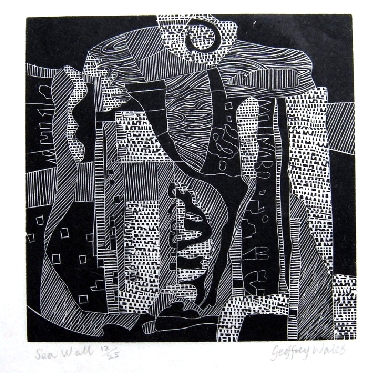
Sea Wall
Wood engraving 1962
Signed and numbered 12/25
115 x115mm
In the 1960’s his work ‘involved even more fragmented imagery and reduction in form, but it was becoming obvious that the more classical and controlled aspects were gaining ascendency”
Around this time he began to make collages – ‘small beautifully executed assemblages…from his own printed papers with areas of frottage’ these were ‘experimental exercises exploring form, texture and tone.. (they were) developed from the many drawings that filled his sketchbooks’. “most could be described as abstract compositions though they still suggest the landscape & coastal subjects they were inspired by.”
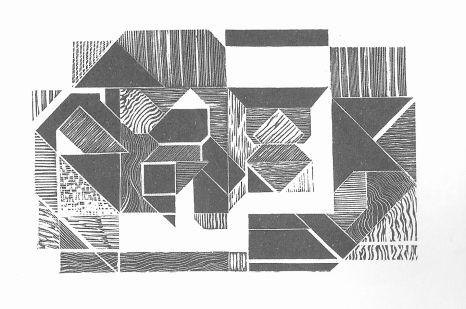
Wooden Wall
Wood engraving 1966
125 x199 mm
A deeply private person, whose creative output was limited to mainly editions of 25 with a few early prints being produced up to 50 times, Wales eschewed the limelight and self promotion, preferring to work in ‘self imposed exile’ until he and Marjorie exhibited together in 1965 in Norwich. The Eastern Daily Press described the work as ‘modern without being provocative’ after which his output slowed to smaller and smaller editions with some later work only printed a couple of times for his own archive.
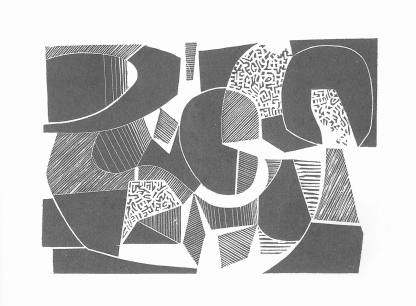
Moving Forms
Wood engraving 1969/70
100 x145mm
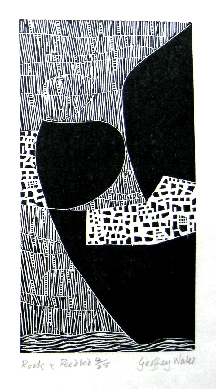
Rocks and Reedbed
Wood engraving 1978
Signed and numbered 4/25
140 x 73mm

Garden Cluster.
Wood engraving. 1978
140 x 90mm. Signed and numbered 3/25.
His final most intriguing works, certainly the ones most appealing to me were produced in the late 1960’s, 1970’s up to the mid 1980’s are the culmination of his exploration of form and subject, the dense black shapes set against ‘a web of fine lines’ giving the prints a ‘visual impact’ that is rarely seen especially in the form of wood engraving. He also experimented with separate blocks yet always stayed with the monochrome palette and never added colour to his prints. Perhaps this was why during his lifetime his work was not widely viewed as fashionable.

Rocks and Reedbed
Wood engraving 1978
Signed and numbered 4/25
140 x 73mm
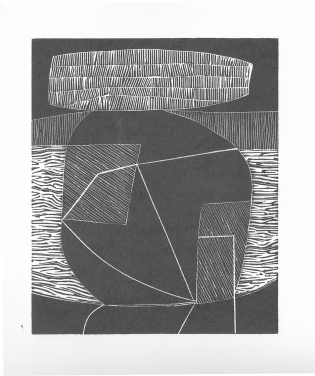
Stones by the Sea
Wood engraving 1980
125 x104 mm
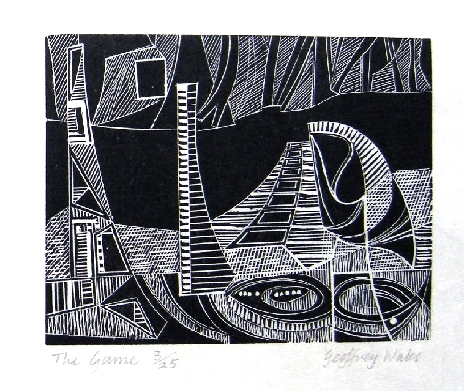
The Game
Wood engraving 1984
Signed and numbered 3/25
90 x115mm
His final works were created towards the end of his life, when his eyesight was failing and he had no interesting in exhibiting. Many were left in a draw or given away to friends and family.
He died in 1990 and in 1992 Hilary Chapman curated a retrospective of his work. She was in contact with his widow Marjorie, who helped inform much of the book published in 1998.
I think it is a crying shame that these adventurous and immersive prints with their wonderful use of mark making, form and shape are left languishing away from a potentially appreciative audience. I have shared some of the images with fellow printmakers who reacted positively but with surprise that he was not more well known. Hopefully time will be kinder on this gentle but exciting printmaker.
Bibliography
http://www.hilarychapmanfineprints.co.uk/
https://www.oakknoll.com/pages/books/52032/hilary-chapman/geoffrey-wales-edited-by-simon-brett

